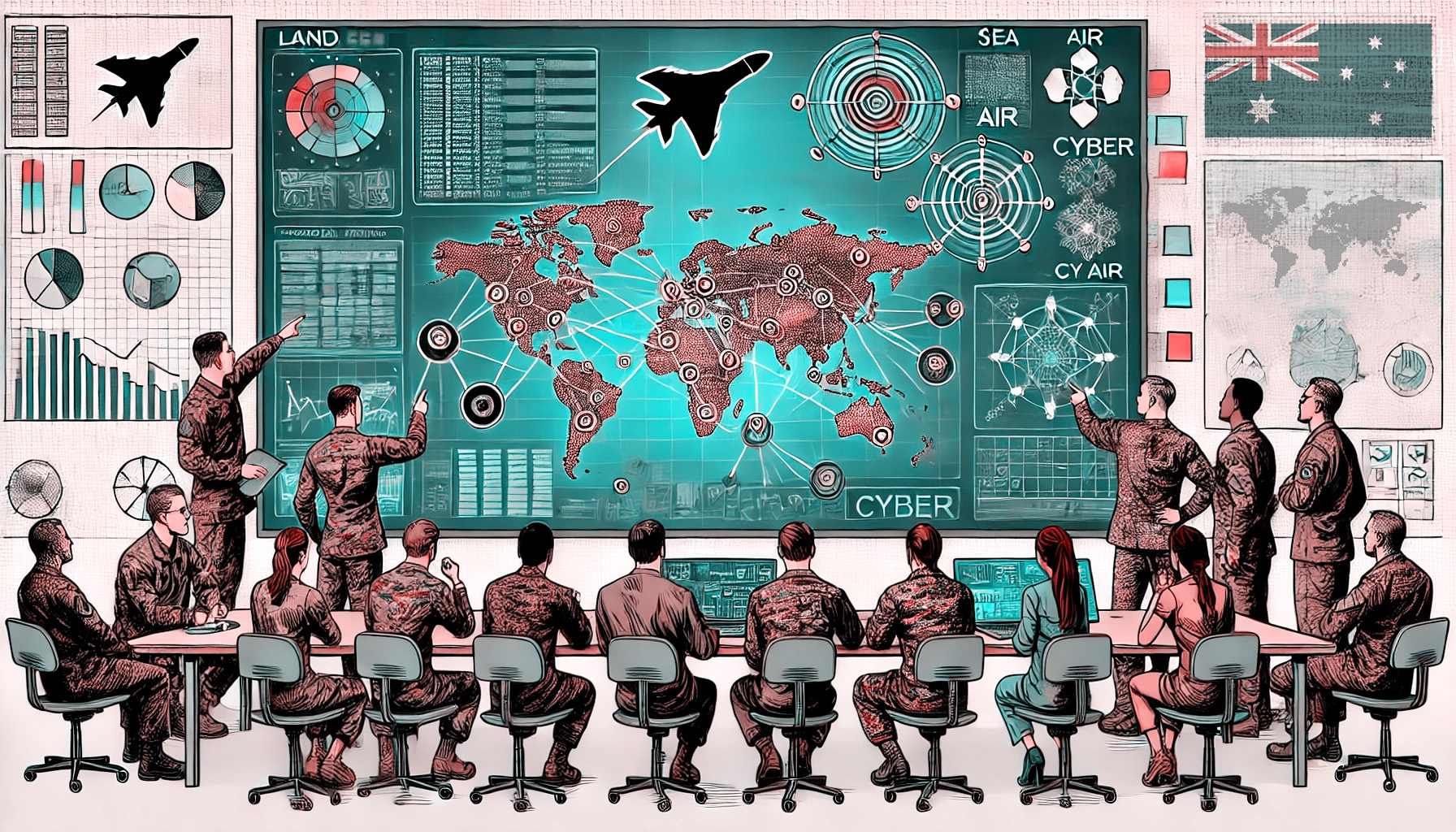Introduction
Integrated Campaigning serves as the Australian Defence Force’s (ADF) loadstone for incorporating its military operations into larger Whole of Australian Government (WoAG) and Multi-Nation Coalition (MNC) operations domestically, regionally, and globally.[1] As a middle power, Australia has always operated beyond its borders alongside its allies and partners as part of a MNC, because it does not possess the requisite national power to do so independently.[2] The partners Australia will cooperate with depend on what type of operations are being conducted, and what direction the Australian Government provides its departments. Generally, regional Humanitarian And Disaster Relief (HADR) or United Nations (UN) led peacekeeping missions will see a broader coalition of nations working together as a MNC to achieve peaceful aims.
As military operations transition through graduated postures of cooperation, competition and conflict, the number of nations Australia cooperates with under a MNC may decrease to include nations under key alliances like The Five Eyes community, employing common military hardware at higher levels of integration, or expand to include other nations with common strategic interests across the Indo-Pacific region operating under different areas of responsibility.[3] Regardless of the size and scale of forces applied, Australia’s Integrated campaigning process is critical to achieving its strategic aims as a middle power, with the ADF serving as a key department to successfully execute this process through doctrine including its 2023 Integrated Campaigning capstone concept, ADF-P-3 Campaigns and Operations, ADF-I-3 Civil Military Interaction and ADFP 5.0.1 Joint Military Appreciation Process (JMAP).[4]
Navy, Army and Air Force must possess equal skill and ability when applying operational art through JMAP, to conduct effective integrated campaigning through an appreciation of each service’s domain expertise, to realise Australia’s national strategic interests. An analysis of the ADF’s application of integrated campaigning across its three services will identify that the ADF must further improve its Joint Professional Mastery and Education (JPME) program so the ADF can integrate more effectively with other Australian Government Departments (OGD) and MNCs as part of its routine business. This essay will propose how the ADF can improve the integrated campaigning experience of its staff and apply applicable doctrine more effectively.
This essay will also support the ADF’s doctrinal approach to integrated campaigning, by assessing that current doctrine will remain applicable into the near future, as a means to realising Australia’s strategic ends as a middle power in accordance with strategic guidance presented in the 2023 Defence Strategic Review (DSR) and ADF Theatre Concept ASPIRE.[5] This essay will also support the ADF approach to integrated campaigning as being effective for synchronising effects with OGDs, and Australia’s allies. However, this essay will challenge the effectiveness of integrated campaigning by reiterating that its effective conduct is dependent on ADF experience and requires ongoing routine integration to remain effective.
Improving ADF experience to ensure integrated campaigning can meet the requirements of the 2023 DSR
A key issue the ADF must address to improve its conduct of integrated campaigning, to satisfy the capstone doctrine as outlined in the 2023 DSR and ADF Theatre Concept ASPIRE, relates to how each service in the ADF trains its personnel to conduct integrated and joint planning. As highlighted in ADF-P-3, the ADF contributes to integrated campaigning through its application of operational art, and that the ADF applies operational art through the ADFP 5.0.1.[6] Operational art utilises ADFP 5.0.1 to translate of strategic aims into operational and tactical actions that considers risk through an Ends, Ways and Means approach.[7] An argument exists that across Navy, Army and Air Force, only the Army currently trains its staff to the level required to achieve successful application of operational art at a joint level, through the application of JMAP. Because the application of operational art is a key requirement to the ADF’s successful conduct of integrated campaigning, it could be further improved across the joint force to realise the requirements of the Integrated Planning capstone document. ADF senior leadership acknowledges the joint force’s current gaps in JPME and released the updated Australian JPME Continuum in 2022 to define where improvements must be made.[8]
The 2023 Australian Command and Staff Course (ACSC) AWC705 Joint Operations Planning Course (JOPC) observed during post exercise debriefing that Australian Navy and Air Force JMAP experience was comparatively limited, compared to Army.[9] The causes for this can be attributed to different PME approaches for the Army as generalists, compared to the Navy and Air Force as technical specialists. In comparison to Navy and Air Force, Army invests a greater amount of JMAP related training into their officers through various single service formats of the Military Appreciation Process (MAP), which employ generalist processes and language aligned to JMAP. Upon commencing officer training at the Australian Army’s Royal Military College (RMC), Army officers start learning the Individual Military Appreciation Process (IMAP), which is employed tactically up to the company level during and after initial officer training at RMC.[10] As Army officers progress and gain staff officer exposure, they also utilise the Staff Military Appreciation Process (SMAP), which is employed up to the Brigade level.[11] By Captain rank, Army Officers consolidate IMAP and SMAP training through the Army Land Warfare Centre’s All Corps Major Course (ACMC), preparing them for joint and integrated postings before they promote to Major.[12] By gaining early MAP training at the start of their careers, Army officers are relatively versed at the application of the language and process applicable to operational art, and tend to apply JMAP more effectively than their peers in Navy and Air Force.
Comparatively, Navy and Air Force do not utilise MAP at all within their single service environments, due to respectively focusing on operational art through the Naval Planning Process (NPP) and Air Tasking Order (ATO) cycle as technical specialists. Despite service expectations that Navy and Air Force officers will gain joint exposure through the completion of the ADF Warfare Training Centre’s (ADFWTC) Introduction to Joint Warfare course, the reality is that a course conducted over a fortnight with zero consolidation does not satisfy this requirement.[13] The only MAP training afforded to Navy and Air Force officers prior to ACSC is the ADFWTCs delivered JOPC, targeting tri-service Navy Lieutenants and Lieutenant Commanders, Army Captains and Majors, and Air Force Flight Lieutenants and Squadron Leaders.[14] JOPC courses are frequently over-subscribed and prioritised to staff officers posted to Joint Operations Command (JOC). Too many staff are unsuccessful in panelling onto the course and may not get their first exposure to JOPC until they do ACSC. For Navy and Air Force, this timeline for JOPC training is too late in their careers, with many Navy and Air Force students on ACSC being promoted to Commander and Wing Commander upon graduating ACSC.
Addressing the lack of joint training and experience for ADF officers could be achieved through an organisational review that realigns JPME expectations across the ADF’s three services to improve standards of operational art application, thus improving the ADF’s ability to conduct successful integrated planning.[15] One outcome of the 2023 DSR accepted by the ADF was the requirement to establish a Chief of Personnel (CPERS) within Defence People Group (DPG), tasked with achieving consistency in managing postings, promotions and qualifications across Navy, Army and Air Force.[16] The establishment of CPERS occurred on 01 July 2023 and as part of the restructuring of the ADF, the Australian Defence College (ADC) relocated from the command of the Chief of Joint Capabilities (CJC) to the command of CPERS.[17] The ADC owns the Directorate of JPME which also transitioned to CPERS. ADCs transition from CJC to CPERS presents an opportunity for the ADF to improve its standardisation of JPME across all three services, in accordance with the expectations of the Australian JPME Continuum.[18]
The ADF’s Chief of the Defence Force (CDF) could direct the Chief of the Navy, Chief of the Army and Chief of the Air Force to support CPERS by ensuring their staff are meeting JPME requirements. The opportunity exists to standardise JOPC operational art training across all three services of the ADF, starting at the ranks of Lieutenant, Captain, and Flight Lieutenant as officers get close to senior officer promotion. Improving tri-service standards of JOPC training will ensure the ADF can adequately apply its operational art to integrated campaigning through its ADF Campaigning cycle, and in doing so, ensure the ADF is able to adapt to the challenges outlined in the 2023 DSR.[19] To manage JPME effectively, CPERS could address current short falls by influencing postings and promotions for all three services under the direction of CDF, balanced against Navy and Air Force ensuring post graduate technical mastery requirements are maintained through Preparedness assessments.
One option to realise JPME requirements could be through the introduction of a joint version of Army’s ACMC, targeting Army Captains, Navy Lieutenants and Air Force Flight Lieutenants as a career progression requirement ahead of senior officer promotion. The ideal ranks would be targeted because Technical Mastery progression continues while joint Social Mastery and Defence Mastery commence earlier, through operational art exposure.[20] Once the ADF realises standardised experience in joint planning across its three services, it can focus further on improving its integration with its OGDs to achieve WoAG strategic objectives, along with regional allied integration to achieve MNC strategic objectives.
Australia’s “Niche” middle power diplomacy and opportunities to improve the ADF’s approach to Integrated Campaigning
Australia is described as having employed a “niche” middle power diplomacy in the post-World War Two era, through its emphasis and effort to address military security and non-traditional security challenges across the Indo-Pacific region through broader MNC objectives.[21] As great power competition plays out across the Indo-Pacific region between an established United States of America (US) and rising China, Australia is in the unique position to influence change aligned to its national strategic interest through its middle power diplomacy by collaborating with the US and other allies, tipping the balance of power in Australia and its allies favour through MNC collaboration.[22] Australia can also represent the interests of regional small and weak powers through collaboration of its military efforts via integrated campaigning.[23] A challenge the ADF faces today however, is the lack of integrated campaigning its people actually get exposed to. The requirement for Australia’s government agencies to work together more often and more closely couldn’t be more overt; the 2023 DSR and ADF Theatre Concept ASPIRE make this perfectly clear.[24] However, the reality the ADF faces is that the majority of exposure and experience its people achieved in recent decades has been through MNC operations with allies in the Middle East, particularly the US. Increased MNC experience was achieved as a consequence of the September 11 terrorist attacks in 2001, through operations in Afghanistan and Iraq, spanning across the first two decades of the twenty first century.
MNC operations have been inherently easy to achieve by the ADF when compared to WoAG operations, because Australia’s allies follow similar military doctrine processes for integrated campaigning and the application of operational art. A similar approach exists to execute operations, utilising similar platforms and hardware. Accordingly, Australia’s greatest challenge remains in its experience on applying its doctrine to successfully conduct integrated campaigning. Australia’s primary strategic allies are the US and the United Kingdom (UK), as defined by the 2022 AUKUS Alliance.[25] The US and UK integrate operational art in a manner similar to Australia. The US employs operational art through Joint Publication 5-0 Joint Planning.[26] The UK employs the NATO Standard Allied Joint Publication 5: Allied Joint Doctrine for the Planning of Operations.[27] Both documents employ an operation planning process similar to that of the ADF’s ADFP 5.0.1, with the UK doctrine also being applicable to NATO, an alliance that Australia is not a part of but has integrated with closely over the past two decades in Afghanistan during the Global War Against Terror.[28]
To align with the aims of the 2023 DSR and ADF Theatre Concept ASPIRE, Australia can now focus its attention on improving its military integration with its regional allies. While Australia will conduct operations across the Indo-Pacific, it’s alliances most certainly expand beyond AUKUS, therefore the ADF must be able to effectively conduct integrated campaigning with its Indo-Pacific partners. Additional key Alliances include the ANZUS treaty, with New Zealand (NZ) gaining access to common intelligence and the operational integration of common hardware through the Five Eyes partnership incorporating Australia, Canada, NZ, the UK and the US.[29] Australia is also a partner of the Five Power Defence Arrangements (FPDA), consisting of Australia, NZ, Malaysia, Singapore and the UK. Despite the FPDA operating for over 50 years since forming in 1971, it still lacks some arrangements to fully share Integrated Air Defence System (IADS) data amongst all participants.[30] It can however, share its operational art and integrated campaigning doctrine with its participants, along with other key partners including the QUAD Strategic Dialogue nations of India and Japan, US ally North Korea, ASEAN partner nations including Brunei, Cambodia, Indonesia, the Philippines, Thailand and Vietnam, and Pacific Island Forum (PIF) nations including Papua New Guinea, Fiji, the Solomon Islands and Tonga.
The ADF achieves integrated campaigning and operational art training with all aforementioned Indo-Pacific nations, plus OGDs including the Department of Foreign Affairs and Trade (DFAT), Maritime Border Command (MBC) and the Australian Federal Police (AFP) on the AWC’s ACSC through its AWC705 JOPC. To further improve training in integrated campaigning and operational art application, the ADF can promote its ADFP 5.0.1 by sharing it with aforementioned countries for employment on their own Command and Staff courses, as ACSC prepares for an increasing Overseas Course Member (OCM) intake on future courses.[31] The increased sharing of ADF doctrine across the Indo-Pacific region will in turn improve the ADF’s integrated campaigning and operational art training experience with its partner nations.
Moving beyond Australia’s ability to integrate with its allies on MNC operations, a renewed focus on WoAG Integrated Campaigning is required to realise the requirements of the 2023 DSR and ADF Theatre Concept ASPIRE.[32] Until recently, the only Australian Government Department to employ an integrated campaigning process was the ADF. However, one positive outcome resultant from the increased employment of the ADF to support fires, floods and pandemics stemming back to 2019 was the creation of the National Emergency Management Agencies’ (NEMA) Crisis Appreciation and Strategic Planning (CASP) doctrine.[33] NEMA’s doctrine was designed from the JMAP and serves as the first example of a WoAG process that integrates the ADF effectively, with JMAP being selected by NEMA when the ADF plays the leading role in a national emergency, or CASP being applied when other emergency services are playing the leading role in a national emergency.[34] CASP is a step in the right direction to achieving WoAG integration processes and serves as the starting point for national coordination within Australia.
Outside of Australia however, improvement is required to realise an effective WoAG planning and integration process across the spectrum of cooperation, crisis and conflict. The ADF predominantly operates with DFAT overseas, with the majority of coordination relating to HADR and Non-combatant Evacuation Operations (NEO).[35] The ADF also supports UN missions, however ADF personnel undergo specific UN training to serve within the UN, so overseas WoAG focus will remain on DFAT.[36] DFAT execute a Crisis Management Framework (CMF) that is led by an Inter-Departmental Management Task Force (IDETF), that the ADF comes under as one of the represented departments.[37] CMF support does not execute against any formalised doctrine, generating two outcomes of the CMF and IDETF requiring experienced personnel to perform its functions effectively, as well as the ADF integrating its campaign effects into the IDETF in isolation through the ADF-P-3, ADF-I-3 and ADFP 5.0.1 doctrine. While experience exists across applicable OGDs to maintain this process, current doctrine is limited to broad CMF descriptions in ADF-I-3.[38] Opportunities exist to improve ADF experience in WoAG operations outside of Australia that must be able to address a broad range of predicted future challenges.
To further improve ADF integration into WoAG operations, the ADF’s ACSC could expand beyond its planned future increase of OCM representation to also include greater OGD representation that experiences AWC705 HADR and NEO planning; particularly from DFAT, MBC and the AFP.[39] Additionally, a WoAG planning and coordination course could be coordinated by an OGD such as the Department of the Prime Minister and Cabinet as the national coordinating agency for Australia’s elected government and National Security Council, to improve national integration.[40] JOC is starting to improve OGD representation in routine J5 theatre campaign planning and international engagement, but the absence in operational art training still exists.[41] It is through the development of a WoAG planning doctrine that the problems identified in this essay can ultimately be overcome.
Any WoAG doctrine would be diverse and broad across its departmental missions and tasks. The best way to overcome this issue would be by creating a national capstone integrated campaigning doctrine, with additional subordinate doctrine applicable to departments, national coordination, and international coordination. ADF doctrine would be subordinate to the parent WoAG capstone doctrine, and affords other departments the example to build upon the ADFP 5.0.1, much like NEMA’s CASP.[42] WoAG doctrine would serve to bridge the gap for the dependence on existing experience and start the ADF journey to grow beyond its own doctrine, to cement a new standard of ADF operational experience that achieves the requirements of the 2023 DSR and ADF Theatre Concept ASPIRE.[43]
Conclusion
Critiquing of the ADF campaign planning framework has highlighted that Australia’s doctrinal approach to integrated campaigning will remain applicable in the near future. The ADF’s doctrine has evolved to remain effective at executing its missions for the Australian Government in isolation, or as part of a MNC with its allies on operations through its commonality with allied doctrine across the US, the UK and NATO.[44] However, this critique has identified that the ADF needs to improve its integrated campaigning experience and baseline skillsets by improving the application of operational art across its three services. The ADF needs to review its JPME program and introduce Joint operational art training earlier to Navy and Air Force personnel as they progress their Technical Mastery, to ensure the joint force is truly capable at conducting integrated planning.[45]
The ADF is only one department within Australia’s government however, and it is already leading the way in developing doctrine and procedures that enable the effective conduct of integrated campaigning. WoAG integration cannot be realised without an effective and promulgated planning process that sets the conditions in which departments will cooperate against the multitude of tasks the WoAG contribution may be directed to perform. ADF doctrine has recently informed NEMAs CASP doctrine because of climate change and its impacts on national emergency coordination in recent times, dating back to the 2019 bushfire crisis in Australia.[46] These lessons provide a basis to look beyond Australia’s shores for WoAG coordination, serving as an example of how integration could be further improved under DFAT led activities in the Indo-Pacific region, where Australia often coordinates with its allies in MNCs.[47]
Allied integration, particularly within organisations that collaborate with militaries, can benefit from existing allied doctrine that is compatible across nations and alliances including Australia, NATO, NZ, the UK and the US. ACSC serves as a prime example of how operational art and integrated campaign training is shared amongst its regional allies, and how it is forecasted to expand in the coming years under 2023 DSR direction.[48] Australia can accordingly capitalise on its middle power relationships to further enhance integrated campaigning across the Indo-Pacific, starting with military departments under alliances including AUKUS, ANZUS and FPDA, as well as strategic organisations including the QUAD dialogue, ASEAN forum and PIF. The pursuit of such goals by the ADF and Australia’s OGDAs have the potential to achieve national and allied strategic aims that can address the challenges faced by the Indo-Pacific region as detailed in the 2023 DSR.[49]
Australian Defence Force Warfare Training Centre: Department of Defence. Introduction to Joint Warfighting Course. Canberra, Commonwealth of Australia. Updated August 25, 2023. http://drnet/JCG/ADC/ADFTC/ADFWTC/Pages/ADF-Introduction-to-Joint-Operations.aspx.
Australian Defence Force Warfare Training Centre: Department of Defence. Joint Operations Planning Course. Canberra, Commonwealth of Australia. Updated August 25, 2023. http://drnet/JCG/ADC/ADFTC/ADFWTC/Pages/ADF-Joint-Operations-Planning-Course.aspx.
ACSC Lecturer (name withheld due Chatham House Rule). National Security Decision Making: Department of the Prime Minister and Cabinet Perspective.Lecture Notes, Australian War College, October 27, 2023.
ACSC Lecturer (name withheld due Chatham House Rule). DFAT and Overseas Crisis Management. Lecture Notes, Australian War College, June 6, 2023.
ACSC Lecturer (name withheld due Chatham House Rule). DSR impacts on the AWC. Lecture Notes, Australian War College, May 9, 2023.
ACSC Lecturer (name withheld due Chatham House Rule). JEX2 Out Brief and Lessons Capture. Lecture Notes, Australian War College, June 30, 2023.
ACSC Lecturer (name withheld due Chatham House Rule). Military Planning at Theatre-Operational Level (Campaigning in Complexity). Lecture Notes, Australian War College, October 27, 2023.
ACSC Lecturer (name withheld due Chatham House Rule). National Emergency Management Agency. Lecture Notes, Australian War College, October 26, 2023.
ACSC Lecturer (name withheld due Chatham House Rule). United Nations Peace Operations. Lecture Notes, Australian War College, October 25, 2023.
Bisley, Nick, Robyn Eckersley, Shahar Hameiri, Jessica Kirk, George Lawson, Benjamin Zala. “For a Progressive Realism: Australian Foreign Policy in the 21st Century”, in Australian Journal of International Affairs, Vol. 76, No. 2. 153. Oxfordshire: Routledge, 2022.
Clausewitz, Carl von. On War. Translated and edited by Michael Howard and Peter Paret. 142-43. Princeton: Princeton University Press, 1984.
Defence People Group: Department of Defence. Defence People Group DPG – Organisational Structure. Canberra, Commonwealth of Australia. Updated August 25, 2023. http://drnet/People/AboutDPG/Pages/Organisational-Structure.aspx.
Department of Defence: Australian Government. ADF Theatre Concept ASPIRE: The Australian Defence Force’s Theatre Concept. 1, 14. Canberra: Commonwealth of Australia, 2023.
Department of Defence: Australian Government. ADF-I-3 Civil-Military Interaction. iii-iv, 21, 52. Canberra: Commonwealth of Australia, 2022.
Department of Defence: Australian Government. ADF-P-3 Campaigns and Operations. Second Edition, AL2. ii, 16-17. Canberra: Commonwealth of Australia, 2021.
Department of Defence: Australian Government. ADFP 5.0.1 Joint Military Appreciation Process. Second Edition, AL3. iii-v, 16-18. Canberra: Commonwealth of Australia, 2021.
Department of Defence: Australian Government. The Australian Joint Professional Military Education Continuum 2.0. Second Edition. 3, 11, 25.Canberra: Commonwealth of Australia, 2018.
Department of Defence: Australian Government. Integrated Campaigning: The ADF’s Cornerstone Concept. iii, 8-9. Canberra: Commonwealth of Australia, 2022.
Department of Defence: Australian Government. Land Warfare Doctrine 5-1-4 The Military Appreciation Process. 124, 265. Canberra: Commonwealth of Australia, 2015.
Department of Defence: Australian Government. National Defence: Defence Strategic Review. 5-9, 18, 58, 72, 87-88, 104, 106-107. Canberra: Commonwealth of Australia, 2023.
Department of Defense: Joint Chiefs of Staff. Joint Publication 5-0: Joint Planning. 3-4, 83. Washington: United States Department of Defence, 2020.
Department of Home Affairs: Australian Government. Crisis Appreciation and Strategic Planning (CASP): Guidebook. 4-5. Canberra: Commonwealth of Australia, 2017.
Gilley, Bruce. “China’s Discovery of Middle Powers,” in Middle Powers and the Rise of China. Edited by Bruce Gilley and Andrew O’Neil. 48. Copenhagen: Djof Publishing, 2014.
Gilley, Bruce, Andrew O’Neil. “China’s Rise Through the Prism of Middle Powers,” in Middle Powers and the Rise of China. Edited by Bruce Gilley and Andrew O’Neil. 8-9. Copenhagen: Djof Publishing, 2014.
Green, Robert. Security Without Nuclear Deterrence. 259. Christchurch: Ashton Media, 2010.
Land Warfare Centre: Department of Defence. 212590 All Corps Major Course (ACMC). Canberra: Commonwealth of Australia. Updated August 25, 2023. http://drnet/Army/HQLWC/Pages/212590%20All%20Corps%20Major%20Course%20ACMC%20-%20CLMT%20-%20OTW.aspx.
Ministry of Defence: United Kingdom Government. NATO Standard: AJP-5 Allied Joint Doctrine for the Planning of Operations. Edition A, Version 2, Change 1. vii, xvii, 164. Arncott: Ministry of Defence, 2021.
Wilkins, Thomas S. “Australia: A Traditional Middle Power Faces the Asian Century,” in Middle Powers and the Rise of China. Edited by Bruce Gilley and Andrew O’Neil. 162. Copenhagen: Djof Publishing, 2014.
1 Department of Defence: Australian Government, Integrated Campaigning: The ADF’s Cornerstone Concept, (Canberra: Commonwealth of Australia, 2022), 8.
2 Bisley, et al, “For a Progressive Realism: Australian Foreign Policy in the 21st Century,” in Australian Journal of International Affairs, Vol. 76, No. 2, (Oxfordshire: Routledge, 2022), 153.
3 Department of Defence, Integrated Campaigning: The ADF’s Cornerstone Concept, 9.
4 Department of Defence, Integrated Campaigning: The ADF’s Cornerstone Concept, iii; Department of Defence: Australian Government, ADF-P-3 Campaigns and Operations, 2nd Ed, AL2, (Canberra: Commonwealth of Australia, 2021), ii; Department of Defence: Australian Government, ADF-I-3 Civil-Military Interaction, (Canberra: Commonwealth of Australia, 2022), iii-iv; Department of Defence: Australian Government, ADFP 5.0.1 Joint Military Appreciation Process, 2nd Ed, AL3, (Canberra: Commonwealth of Australia, 2021), iii-v.
5 Department of Defence: Australian Government, ADF Theatre Concept ASPIRE: The Australian Defence Force’s Theatre Concept, (Canberra: Commonwealth of Australia, 2023), 1, 14; Department of Defence: Australian Government, National Defence: Defence Strategic Review, (Canberra: Commonwealth of Australia, 2023), 18.
6 Department of Defence, ADF-P-3 Campaigns and Operations, 16.
7 Department of Defence, ADFP 5.0.1 Joint Military Appreciation Process, 17-18; Carl von Clausewitz, “War is and Instrument of Policy,” in On War, trans, ed. Michael Howard and Peter Paret (Princeton NJ: Princeton University Press, 1984), 142-43.
8 Department of Defence: Australian Government, The Australian Joint Professional Military Education Continuum 2.0, 2nd Ed., (Canberra: Commonwealth of Australia, 2018), 3.
9 ACSC Lecturer (name withheld due Chatham House Rule), JEX2 Out Brief and Lessons Capture, (Lecture Notes, Australian War College, June 30, 2023).
10 Department of Defence: Australian Government, Land Warfare Doctrine 5-1-4 The Military Appreciation Process, (Canberra: Commonwealth of Australia, 2015), 265.
11 Department of Defence, Land Warfare Doctrine 5-1-4 The Military Appreciation Process, 124.
12 Land Warfare Centre: Department of Defence, 212590 All Corps Major Course (ACMC), (Canberra: Commonwealth of Australia), updated August 25, 2023, http://drnet/Army/HQLWC/Pages/212590%20All%20Corps%20Major%20Course%20ACMC%20-%20CLMT%20-%20OTW.aspx.
13 Australian Defence Force Warfare Training Centre: Department of Defence, Introduction to Joint Warfighting Course, (Canberra, Commonwealth of Australia), updated August 25, 2023, http://drnet/JCG/ADC/ADFTC/ADFWTC/Pages/ADF-Introduction-to-Joint-Operations.aspx.
14 Australian Defence Force Warfare Training Centre: Department of Defence, Joint Operations Planning Course, (Canberra, Commonwealth of Australia), updated August 25, 2023, http://drnet/JCG/ADC/ADFTC/ADFWTC/Pages/ADF-Joint-Operations-Planning-Course.aspx.
15 Department of Defence, The Australian Joint Professional Military Education Continuum 2.0, 25.
16 Department of Defence, National Defence: Defence Strategic Review, 87-88, 107.
17 Defence People Group: Department of Defence, Defence People Group DPG – Organisational Structure, (Canberra, Commonwealth of Australia), updated August 25, 2023, http://drnet/People/AboutDPG/Pages/Organisational-Structure.aspx.
18 Department of Defence, The Australian Joint Professional Military Education Continuum 2.0, 25.
19 Department of Defence: Australian Government, ADF-P-3 Campaigns and Operations, 17; Department of Defence, National Defence: Defence Strategic Review, 18.
20 Department of Defence, The Australian Joint Professional Military Education Continuum 2.0, 11.
21 Thomas S. Wilkins, “Australia: A Traditional Middle Power Faces the Asian Century,” in Middle Powers and the Rise of China, eds. Bruce Gilley and Andrew O’Neil, (Copenhagen: Djof Publishing, 2014), 162.
22 Bruce Gilley and Andrew O’Neil, eds., “China’s Rise Through the Prism of Middle Powers,” in Middle Powers and the Rise of China, (Copenhagen: Djof Publishing, 2014), 8-9.
23 Bruce Gilley, “China’s Discovery of Middle Powers,” in Middle Powers and the Rise of China, eds. Bruce Gilley and Andrew O’Neil. (Copenhagen: Djof Publishing, 2014), 48.
24 Department of Defence, ADF Theatre Concept ASPIRE: The Australian Defence Force’s Theatre Concept, 1; Department of Defence, National Defence: Defence Strategic Review, 18.
25 Department of Defence, National Defence: Defence Strategic Review, 58, 72, 104, 106.
26 Department of Defense: Joint Chiefs of Staff, Joint Publication 5-0: Joint Planning, (Washington: United States Department of Defence, 2020), 3-4.
27 Ministry of Defence: United Kingdom Government, NATO Standard: AJP-5 Allied Joint Doctrine for the Planning of Operations, Ed. A, V. 2, Ch. 1, (Arncott: Ministry of Defence, 2021), vii, xvii.
28 Department of Defence: Australian Government, ADFP 5.0.1 Joint Military Appreciation Process, 16; Department of Defense: Joint Chiefs of Staff, Joint Publication 5-0: Joint Planning, 83; Ministry of Defence, NATO Standard: AJP-5 Allied Joint Doctrine for the Planning of Operations, 164.
29 Robert Green, Security Without Nuclear Deterrence. (Christchurch: Ashton Media, 2010), 259.
30 ACSC Lecturer (name withheld due Chatham House Rule), Military Planning at Theatre-Operational Level (Campaigning in Complexity), (Lecture Notes, Australian War College, October 27, 2023).
31 ACSC Lecturer (name withheld due Chatham House Rule), DSR impacts on the AWC, (Lecture Notes, Australian War College, May 9, 2023).
32 ACSC Lecturer (name withheld due Chatham House Rule), National Emergency Management Agency, (Lecture Notes, Australian War College, October 26, 2023).
33 Department of Home Affairs: Australian Government, Crisis Appreciation and Strategic Planning (CASP): Guidebook, (Canberra: Commonwealth of Australia, 2017), 4-5.
34 ACSC Lecturer (name withheld due Chatham House Rule), National Emergency Management Agency, (Lecture Notes, Australian War College, October 26, 2023).
35 ACSC Lecturer (name withheld due Chatham House Rule), DFAT and Overseas Crisis Management, (Lecture Notes, Australian War College, June 6, 2023).
36 ACSC Lecturer (name withheld due Chatham House Rule), United Nations Peace Operations, (Lecture Notes, Australian War College, October 25, 2023).
37 ACSC Lecturer (name withheld due Chatham House Rule), DFAT and Overseas Crisis Management, (Lecture Notes, Australian War College, June 6, 2023).
38 Department of Defence: Australian Government, ADF-I-3 Civil-Military Interaction, 21, 52.
39 ACSC Lecturer (name withheld due Chatham House Rule), DSR impacts on the AWC, (Lecture Notes, Australian War College, May 9, 2023).
40 ACSC Lecturer (name withheld due Chatham House Rule), National Security Decision Making: Department of the Prime Minister and Cabinet Perspective, (Lecture Notes, Australian War College, October 27, 2023).
41 ACSC Lecturer (name withheld due Chatham House Rule), Military Planning at Theatre-Operational Level (Campaigning in Complexity), (Lecture Notes, Australian War College, October 27, 2023).
42 ACSC Lecturer (name withheld due Chatham House Rule), National Emergency Management Agency, (Lecture Notes, Australian War College, October 26, 2023).
43 Department of Defence: Australian Government, National Defence: Defence Strategic Review, 18; Department of Defence: Australian Government, ADF Theatre Concept ASPIRE: The Australian Defence Force’s Theatre Concept, 1, 14.
44 Department of Defence: Australian Government, ADFP 5.0.1 Joint Military Appreciation Process, 16; Department of Defense: Joint Chiefs of Staff, Joint Publication 5-0: Joint Planning, 83; Ministry of Defence, NATO Standard: AJP-5 Allied Joint Doctrine for the Planning of Operations, 164.
45 Department of Defence, The Australian Joint Professional Military Education Continuum 2.0, 25.
46 ACSC Lecturer (name withheld due Chatham House Rule), National Emergency Management Agency, (Lecture Notes, Australian War College, October 26, 2023).
47 ACSC Lecturer (name withheld due Chatham House Rule), DFAT and Overseas Crisis Management, (Lecture Notes, Australian War College, June 6, 2023).
48 ACSC Lecturer (name withheld due Chatham House Rule), DSR impacts on the AWC, (Lecture Notes, Australian War College, May 9, 2023).
49 Department of Defence: Australian Government, National Defence: Defence Strategic Review, 5-9.









Comments
Start the conversation by sharing your thoughts! Please login to comment. If you don't yet have an account registration is quick and easy.